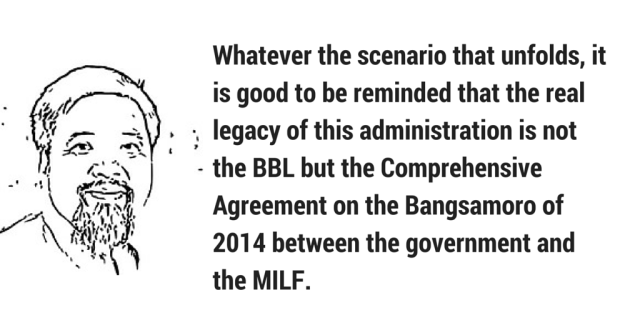‘Constitutionally compliant’ BBL
- Details
- Blog Content
- Hits: 4619
Fr. Eliseo "Jun" Mercado is senior policy adviser at the Institute for Autonomy and Governance. His views are his own.

There is a consensus between Congress and Malacañang that the Bangsamoro Basic Law (BBL) that will be enacted is within the framework of the Constitution and consistent with national laws.
What is a “constitutionally compliant” BBL? How different is it from the proposed BBL submitted to Congress in September 2014?
The first understanding of a “constitutionally compliant” BBL follows the legal brief prepared by former Supreme Court Justice Vicente Mendoza, who raised the questionable constitutional concepts that are in the proposed BBL. These are: 1) the use and understanding of territory as ancestral domain; 2) the definition and understanding of the Bangsamoro people; 3) the concept and understanding of the Bangsamoro government; 4) the exclusive powers of the Bangsamoro government; 5) the general supervision of the President over the Bangsamoro government; and 6) the concept and understanding of the asymmetric relationship between the national government and the Bangsamoro government.
Added to the six questionable constitutional concepts are the nine provisions in the proposed BBL that are being considered for deletion, for being “unconstitutional” and/or unacceptable by the ad hoc House committee on the BBL. These are: a) the creation of a separate Commission on Audit; b) the creation of a separate Commission on Elections; c) the creation of a separate Civil Service Commission; d) the creation of a separate Commission on Human Rights; e) the creation of a separate Office of the Ombudsman; f) the sections that require the President to coordinate military operations with the chief minister of the envisioned Bangsamoro Autonomous Region; g) the sections that empower the chief minister to have control and supervision over the police force in the region; h) the parliamentary setup in the region; and i) the provision authorizing the conduct of a plebiscite in any territory contiguous to the region where 10 percent of residents want to join it.
A “constitutionally compliant” BBL will follow the Malacañang position that says: “Any BBL will be acceptable.” The real issue is whether such a “constitutionally compliant” BBL will be acceptable to the Moro Islamic Liberation Front (MILF).
There are three possible scenarios: 1) The MILF leadership accepts whatever BBL Malacañang is able to deliver by way of congressional legislation; 2) the MILF leadership rejects “any BBL” that is not faithful to the letter and spirit of the Comprehensive Agreement on the Bangsamoro of 2014; and 3) a segment of the MILF leadership accepts whatever BBL Malacañang delivers and the other segment rejects it; the former will run and manage the new Bangsamoro Autonomous Region and the latter will continue the Bangsamoro struggle.
The first scenario presents a déjà vu option (similar to Republic Act No. 9054, albeit an improvement) for both the government and the MILF. The second tells us that the peace process has not been concluded under the Aquino administration and will continue into the next. And the third divides the MILF into those accepting “any BBL” and those rejecting it.
But whatever the scenario that unfolds, it is good to be reminded that the real legacy of this administration is not the BBL but the Comprehensive Agreement on the Bangsamoro of 2014 between the government and the MILF.

